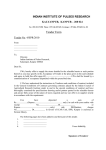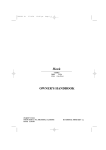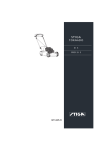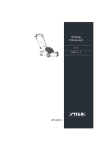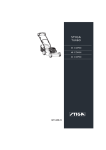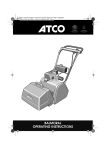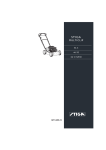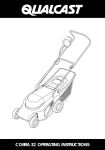Download Qualcast 16/18 Operating instructions
Transcript
PETROL/ROTARY 16/18 LAWNMOWER OPERATING INSTRUCTIONS Safety Rules Read the instructions carefully. Be familiar with the controls and the proper use of the lawnmower. Explanation of symbols on the lawnmower:1) General hazard safety alert. 2) Read Instruction manual. Mowing on banks can be dangerous:- Do not mow excessively steep slopes. - Be particularly careful of your footing on slopes or wet grass. - Mow across the face of slopes - not up and down. - Use extreme caution when changing direction on slopes. - Use extreme caution when stepping back or pulling the lawnmower towards you. 3) Beware of thrown objects to bystanders. 4) Keep bystanders a safe distance away from the machine. 5) Remove spark plug lead before maintenance. Stop the engine if the lawnmower has to be tilted for transportation when crossing surfaces other than grass and when transporting the lawnmower to and from the area to be mowed. Never operate the lawnmower without the grassbag or deflector guard in position. Never operate the lawnmower with a defective deflector guard. 6) Sharp blade(s). Beware of severing toes or fingers. Wait until all machine components have completely stopped before touching them. Never allow children or people unfamiliar with these instructions to use the lawnmower. Local regulations may restrict the age of the operator. Do not change the engine governor settings or over speed the engine. Operating an engine at excessive speed may increase the hazard of personal injury. Start the engine carefully according to instructions and with feet well away from the blade(s). Do not tilt the mower when starting. Do not put hands or feet near, or under, rotating parts while the lawnmower is being operated. Never mow while people, especially children or pets are nearby. Stop the engine and disconnect the spark plug wire: - before checking, cleaning or working on the lawnmower; Never pick up or carry the lawnmower while the engine is running. - Keep in mind that the operator, or user, is responsible for accidents or hazards occurring to other people or their property. after striking a foreign object. Inspect the lawnmower for damage and make repairs before restarting and operating the lawnmower; - if the lawnmower starts to vibrate abnormally (check immediately). While mowing, always wear substantial footwear and long trousers. Do not operate the equipment when barefoot or wearing open sandals. - before making height of cut adjustment. Thoroughly inspect the area where the lawnmower is to be used and remove all objects which may be thrown by the machine. - whenever you leave the lawnmower; - before refuelling; - before clearing blockages; WARNING - Petrol is highly flammable. Reduce the throttle setting during engine shutdown. - Store fuel in containers specifically designed for this purpose. Keep all nuts, bolts and screws tight to be sure the lawnmower is in safe working condition. - Refuel outdoors only and do not smoke while refuelling. - Add fuel before starting the engine. Never remove the cap of the fuel tank or add petrol while the engine is running or when the engine is hot. Replace worn or damaged blade and blade bolts in sets to preserve balance. - - If petrol is spilled, do not attempt to start the engine but move the machine away from the area of spillage and avoid creating any source of ignition until petrol vapours have dissipated. Replace the fuel tank and container caps securely. Do not operate the engine in a confined space where dangerous carbon monoxide fumes can collect. Stop the engine: Never store the lawnmower with petrol in the tank inside a building where fumes may reach an open flame or spark. Allow the engine to cool before storing in any enclosure. To reduce the fire hazard, keep the engine, silencer, identification plate compartment and petrol storage area free of grass, leaves or excessive grease. Check the grassbox frequently for wear or deterioration. Replace worn or damaged parts for safety. Before using, always visually inspect to see that the blades, blade bolts and cutter assembly are not worn or damaged. Ensure only replacement parts fitted are Atco-Qualcast approved. Mow only in daylight or in good artificial light. If the fuel tank has to be drained, this should be done outdoors. Avoid operating the lawnmower in wet grass, where feasible. Walk, never run. Assembly Introduction Thank you for buying your new lawnmower. This manual gives instructions on the correct assembly and safe use of your mower. It is important that you read these instructions carefully. Your mower may be fitted with a Briggs & Stratton engine, please follow the appropriate instructions and diagrams. Assembling the deflector guard assembly to the mower: 1. Insert the left hand end of the hinge pin in the left hand handle bracket hole Fig 1, then locate the right hand end of the hinge pin in the right hand handle bracket. When fully assembled the machine weighs approximately 32kg. If necessary, obtain assistance to remove from packaging. 2. Using a screwdriver to push the pin Fig 1A so that the groove Fig 1B is visible. 3. Fit the clip Fig 1C to the groove Fig 1B. 4. To tension the deflector guard springs locate the ends of the springs under the lugs, as shown in Fig 1D. When correctly assembled the deflector gurard is under spring tension even when it is in the down position against the mower. Take care when pushing the machine over uneven surfaces. Never lift the machine unless you feel it is comfortably light enough to do so. Obtain assistance if you have tight areas or obstacles to negotiate. Please record the following information. It will help your service agent if you ever need assistance or spare parts. The information is located on a label on the rear of the machine. Assembling the handles: 1. Assemble the handles Fig 2. Ensure that the rope guide Fig 2 is fitted on the right hand side of the handle Fig 2. DO NOT ROUTE ENGINE BRAKE CABLE THROUGH ROPE GUIDE, USE CABLE CLIPS FIG 2C SUPPLIED TO SECURE TO HANDLE. 2. Attach rope to the rope guide by looping the rope in a anti-clockwise direction Fig 3A. Model Nº Serial Nº Date of purchase Intended Use This product is intended for domestic lawn mowing. Assembling Grassbox: 1. Unpacking Carefully remove the machine from its packaging and check that you have all the following items: 1. Mower 2. Handle top 3. Handle bottom 4. Grassbox halves 5. Deflector guard, 2 springs (LH & RH) and hinge pin. 6. A hardware pack containing: Mower Operating Instructions, 4 wingnuts, 2 bolts (square shank),4 bushes, 2 plastic spacers, 4 locknuts, 4 short handle bolts, rope guide/bolt, 2 cable clips, Engine manual and Machine Registration Card If any components are missing please call the Consumer Care Hotline on (01449) 742130 for assistance. We also have a wide network of Qualcast Approved Service Agents who you can contact for service and advice both within and outside the period of the guarantee. For ordering spares/replacements please refer to the parts diagram supplied. Assemble the grassbox Fig 4. IMPORTANT: FAILURE TO FIT THE DEFLECTOR GUARD IS DANGEROUS. Preparation Engine Oil IMPORTANT: THE MOWER IS NOT SUPPLIED WITH OIL IN THE ENGINE, HOWEVER IT IS POSSIBLE THAT THERE IS A SMALL QUANTITY IN THE ENGINE. IT IS ESSENTIAL TO FILL WITH OIL BEFORE STARTING THE ENGINE. Checking and Filling 1. With the mower standing on level ground, unscrew and remove the oil filler plug Fig 5A. 2. Wipe the fill plug clean; refit and tighten the filler cap and then remove it again. Check the oil level. 3. Add a good-quality SAE 30 API SF oil in small quantities at a time, allowing it to settle. For models fitted with Briggs & Stratton, engines: Repeatedly add oil and check the level until it reaches the full mark Fig 5B. The engine may require up to 0.6 litres of oil. Do not overfill. 4. Refit and tighten the oil filler plug. Starting and Stopping Note: It is important to use the recommended oil to avoid damage to your engine. Starting the Engine Petrol 1. For mowers with throttle controls: Move the throttle lever Fig 9A to 2. If the engine is cold, press the primer Fig 8A three times (five times in cold weather). If the engine is warm do not prime. 3. Hold the bale bar Fig 9B against the handle. 4. Pull the starter Fig 9C cord briskly one or more times until the engine starts. Allow the cord to return slowly after each pull. Note: Petrol deteriorates over time. Engine starting may be difficult if you use petrol kept for more than 30 days. Always run the fuel tank dry when storing over 30 days 1. Remove the petrol filler cap Fig 5C and add unleaded petrol to the tank, leaving approximately 6mm of tank space for fuel expansion. 2. Replace the petrol filler cap. 3. Wipe up any spilt petrol from the engine before starting the mower. Using your Mower Grassbox Fitting Grassbox For non grass collection the mower can be used without the grassbox in position, with the deflector guard in the down position. Fitting the grassbox Lift the deflector guard and hold up Fig 6A Fit the grassbox Fig 6B. Removing/Emptying Lift the deflector guard and hold up - remove grassbox. Height of Cut Adjustment To adjust the front and rear wheels push the heightof-cut lever Fig 7A away from the notch Fig 7B. For front wheels - Move lever to the rear to lower wheels, as shown Fig 7. For rear wheels - Move lever forward to lower wheel as shown Fig 7. Always ensure that ALL FOUR WHEELS are at the same height setting. Before mowing 1. 2. 3. Stopping the Engine 1. Release the bale bar Fig 9B. The engine will stop within 3 seconds. To drive the Rear Roller (Self-propelled models only) 1. Start the mower (see above). 2. Squeeze the land drive bale bar Fig 9D towards the top handle. For mowers with throttle control, adjust the speed as required by moving the throttle control Fig 9A between and 4. To stop the drive, release the land drive bale bar Fig 9D. After Mowing/Storage Clean the exterior of the machine thoroughly using a soft brush and cloth. Do not use water, solvents or polishes. Remove all grass and debris, especially from the ventilation slots. Tip the machine backwards or on its side (see Underdeck Access) Fig 10 and clean the blade area. If grass cuttings are compacted in the blade area, remove with a wooden or plastic implement. For storage in excess of 30 days, run the engine until all petrol is used and the engine stops. Store the machine in a dry place. Do not place other objects on top of the machine. Check the engine oil level and fill the petrol tank. (See Preparation). To aid storage loosen the handle wing nuts Fig 2B and fold the handles. Note: Towards the end of the season, it is advisable to put only as much fuel in the tank as you need for each cut, since it should be completely used up before storing the mower. (See After Mowing/Storage). Ensure cable is not trapped when folding/unfolding top handles, DO NOT DROP THE HANDLES. Ensure that the upper handle is in position and secured by the wing nut Fig 2B. Set the height of cut as required .(See Height of Cut Adjustment). Maintenance Stop the engine, and disconnect the spark plug wire. Note: To ensure long and reliable service, carry out the following maintenance regularly. Regularly check for obvious defects such as loose, dislodged or damaged blades, loose fixings, and worn or damaged components. Check that covers and guards are undamaged and correctly fitted. 1 Step 2 Step 4 A D Step 3 Step 1 C C BB 2 A B C C 3 A step 1 step 2 step 3 4 5 AD D FU LL C A B 6 A B C A Briggs & Stratton Classic/Sprint 7 A High B B Low Low High 8 Briggs & Stratton A 9 D A B C 10 Briggs & Stratton A 11 A D C B Under-deck Access bolt Fig 11B and items C to D. Caution: Oil and/or petrol spillage and hard starting may occur unless the following procedure is used when access is required to the underside of the machine. 1. Ensure that the petrol tank is empty or nearly empty. 2. For models fitted with Briggs and Stratton engines: 2. Clean all components and check for damage; renew as necessary. 3. Assemble items A-D as shown, ensuring that the coned washer D and the blade A are the correct way up. 4. Tighten the blade bolt to a torque of 40Nm (29lb ft). Engine Maintenance Remove wing nut and bolt and lower the handle to rest on the floor Fig 10. Stand the machine on its back Fig 10. Do not tip the mower on its side. Perform the following operations at the specified periods to ensure long and reliable service from your mower engine. 1. Change engine oil - refer to engine manual for details. Stand the machine on its back, or its side (see Underdeck Access). Inspect the blade Fig 11A and check that the blade bolt Fig 11B is tight. If the blade is blunt or damaged, fit a new blade. 2. Check starter cord - extend the starter cord and check for wear. 3. Clean/change air filter - refer to engine manual for details. Use the following procedure to remove and replace the blade. 4. Change spark plug - refer to engine manual for details. Blade Maintenance 1. Hold the blade (using gloves or a piece of cloth). Using and referring to Fig 11, remove the Fault Finding The following table gives checks and actions that you can perform if your machine does not operate correctly. If these do not identify/remedy the problem contact your Qualcast approved service agent. Warning - switch engine off and remove spark plug before investigating fault. Symptom Possible Cause Remedy Engine will not start Out of fuel Engine not primed Engine flooded with fuel Fill petrol tank See Starting the Engine Leave for 10-15 minutes; restart without priming Connect lead See engine maintenance manual See Under-deck Access Spark plug lead disconnected Spark plug dirty/worn Machine has been incorrectly tipped on its side Engine stops Out of fuel Cutting blade obstructed Engine speed to low for conditions (Mowers with throttle control) Fill petrol tank Switch off engine and clear obstruction Move throttle Mower leaves ragged finish Height of cut too low Cutting blade blunt Underside of machine badly clogged Blade fitted upside down Increase height of cut Replace blade Clean mower (see After Mowing/ Storage) Refit blade correctly Land drive does not engage (Self propelled models) Drive belt damaged Contact a Qualcast Approved Service Agent Excessive vibration/noise Blade nut/bolt loose Cutting blade damaged Tighten blade nut/bolt Replace blade Noise Certificate Declaration of Conformity PRODUCT: MODEL/TYPE REF: SERIAL NUMBER: MANUFACTURED BY: IDENTIFICATION: Trojan/Quadtrak R434/R484/R484TR See Rating details on machine Castel Garden S.p.A., Castelfranco, Italy Petrol Rotary Lawnmower A Sample of the product has been tested and found to be in conformity with the following Standards: Machinery Directive 89/392/EEC, Noise Level Directive 2000/14/EEC Electromagnetic Compatability Directive 89/336/EEC and Din 1856: 1984 This product has been independently tested for noise in accordance with the EU Noise legislation. The following noise certificate certifies its compliance. We certify that the lawnmower:CATEGORY: MAKE: TYPE: SERIES IDENTIFICATION: MOTOR - MANUFACTURER: MOTOR - Type MOTOR - Speed of rotation during test (1/min) Petrol Qualcast Rotary Lawnmower R434/R484/R484TR Briggs & Stratton 10D902 2900/3000 Conforms to the Specifications of Directive 2000/14/EEC relating to noise level Guaranteed sound power level Measured sound power level 96dB(A) 95dB(A) Type of cutting device Rotary PLACE: Castelfranco, Italy, Blade width (cm) 41/46 DATE: November 2001 Speed of rotation of the cutting device (1/min) 2900/3000 All Certificates and Relevant Test Reports are included in the Technical Construction File which has been agreed with the British Standards Institute, 389 Chiswick High Road, London W4 4AL Signed at Stowmarket Date 2001 SIGNATURE: SIGNATURE: Director - Castel Garden S.p.A. for Atco-Qualcast Ltd. POSITION: Director - Castel Garden S.p.A. for Atco-Qualcast Ltd. The vibrations transmitted at the handle of the machine when in motion do not exceed 8m/s2. (The weighted root mean square acceleration value.) The measurement which determined the maximum level of vibration was carried out on a machine, standing on a hard surface (Reference BS6842: 1987). The airborne noise emission of this machine has been measured at 83dB(A). This is the equivalent continuous A-weighted sound pressure level at the operators position. The level was calculated from the measurements taken during the test carried out in accordance with Noise level directive 81/1051/EEC. Conformity assessment procedure Annexe VI notified Body. SNCH 11 route de Luxemborg, L-5230 Sandweiler. For products numbered: F016L80583 F016L80679 F016L80675 F016L80680 F016L80875 F016L80876 F016L80717 F016L80584 F016L80674 F016L80676 F016L80874 F016L80442 F016L80716 F016L80718 The Guarantee Keep all nuts, bolts and screws tight to be sure that Atco-Qualcast guarantees this product against manufacturing defects. We will repair (or replace at our option) if a manufacturing defect occurs within the guarantee period as long as it has only been subjected to domestic use. For the purpose of this guarantee, domestic use means any use of the product on the property belonging to the purchaser and forming part of the garden area of his/her dwelling. The guarantee period is one year parts and one year labour costs from date of purchase. (Except engine, see engine manual for details.) To obtain a repair under this guarantee: • Take the product to an approved service agent. • Show your dated proof of purchase. • Show this guarantee. The guarantee does not apply if: i. You cannot provide dated proof of purchase. ii. The product has been resold by the original purchaser (this does not apply in the Republic of Ireland), or has been used under hire. iii. The product has been modified to change the manufacturers specifications, or if non genuine replacement parts have been fitted. iv. Any previous repair was undertaken by anyone other than an approved service agent. v. The fault is due to maladjustment, abuse, neglect or accidental damage. vi. The fault is due to lack of lubrication or maintenance. vii. Damage to any part, particularly the drive or cutting mechanism has been caused by allowing the product to strike solid objects. viii. The product develops a fault due to abnormal use. ix. Failure is due to normal wear. The following parts are considered as wearing parts. Their life is dependant on regular servicing and they are not therefore, normally covered by the guarantee: Blades Bearings Cables Belts The cost of routine maintenance of the product is not covered by the guarantee. It is in your best interest to follow the Operating Instructions for your machine, as a properly cared for product should give many years of excellent service. Should you require replacement parts, always insist on genuine Atco-Qualcast replacement parts. Any damage caused to the product through the fitting of parts not made by Atco-Qualcast is not covered by the guarantee. Your statutory rights are not affected by this guarantee. Environmental Information Your product has been manufactured under an environmental management system using, when possible, the most environmentally responsible materials and processes, and with the potential for recycling at the end of its life. The packaging is also recyclable. When the time comes to dispose of this product please consider the environment and take it to a recognised recycling facility. (Please contact your local authority for location information). Atco-Qualcast Ltd, Suffolk Works, Stowmarket, Suffolk, IP14 1EY, England Tel: (01449) 742130 Fax: (01449) 674243 Printed in England F016L69886










